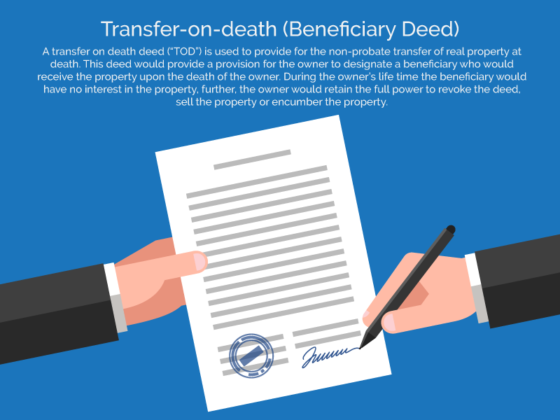Probate and Non-Probate Assets
Not all assets are subject to probate in Texas. Simply stated there are probate assets and non-probate assets.
The Probate Asset
The Probate Asset is an asset that is governed by the terms of a Will. This type of asset will pass through probate. It may also be subject to creditor claims and expenses of administration. Essentially an asset without a beneficiary designation or survivorship arrangement.
The Non-Probate Asset
A Last Will and Testament and Living Trust are important legal documents, but they are not the only documents that can provide for a transfer of assets at death. Generally, a non-probate asset disposition can be provided for in two ways: (1) designate beneficiaries in the documents that control the asset and (2) title the assets properly (ownership).

Non-probate assets often involve the following accounts:
- Bank Accounts
- Investment Accounts
- Retirement Accounts (IRAs & Pension Plans)
- Life Insurance Policies
- Annuity Contracts
- Real Estate
- Vehicles
Bank Accounts
Bank accounts are encountered in almost every estate planning engagement and probate. A bank account is simply a contract between a depositor and a financial institution, typical arrangements include, checking and savings accounts, as well as certificates of deposit. Multiple arrangements exist to transfer assets at death including a transfer of ownership and beneficiary designations.
Pay-on-Death Account
An account can be established as a pay-on-death account. A pay-on-death account is an account in which the owner of the account designates one or more beneficiaries to receive the account upon the death of the account owner. Thus, the owner maintains control and all ownership rights of the account while alive.
The pay-on-death designation is made on the account agreement. You should always review the actual account agreement regarding the non-probate asset disposition arrangement, account owner, and beneficiary designation.
Multi-Party Account
An account can be established to allow the account to be held by more than one owner. The multi-party account can be written to allow for co-ownership and may include a survivorship arrangement, however, note a joint tenant and joint tenant with right of a survivorship account structure are different. Multi-party accounts are often used for convenience of the initial account holder so that account owners would have the right to access and control the account funds.

Joint Tenancy with Right of Survivorship (JTWROS)
An account can be established to allow the account to be held by more than one owner. The multi-party account can be written to allow for co-ownership and this account will include a survivorship arrangement. This arrangement is often used for probate avoidance. Account owners would have the right to access and control the account funds and the survivor would receive the full account upon the death of the initial account holder.
Investment Accounts
Investment and Securities accounts allow for the owner of an account to designate a beneficiary or beneficiaries on an account. The designation can be made by using the form established by the financial institution. The form will designate who will become the owner of the account upon the death of the original account owner.
Retirement Accounts
Retirement accounts include IRAs, 401(k), 403(b) accounts and pension plans. Retirement plans can allow for non-probate beneficiary designations. The issues associated with retirement plans involve beneficiary designation, whether the plan provides for a death benefit or continued payment arrangement and taxation. Since most retirement plan account contributions were not included in taxable income when made, there will be income tax associated with the distributions. Retirement plans can also offer preferred tax benefits for certain beneficiaries and allow for stretch distributions.
Retirement accounts present special attention because the existence of a beneficiary, and who the beneficiary is can determine how quickly the asset has to be distributed and how it is taxed.
Life Insurance Policies
Life insurance policies are contracts between the person who owns the policy and the insurance company. The owner of the policy can designate certain beneficiaries to receive the death benefit of the policy. Careful consideration should be undertaken to determine whether the death benefit needs to be subject to administration or passed outside of formal estate administration. Note, failure to name a beneficiary will subject the death benefit to probate administration.
Beneficiary designations for life insurance contracts can be made to one or more persons in either equal or unequal shares. Further, alternative beneficiary designations can be made to provide for flexibility should the initial beneficiary die. Beneficiary designations need to be made using the insurance company recognized forms and made according to the insurance company guidelines.
Transferring Life Insurance Policies
The actual ownership of the policy can also be transferred.
Ownership transfer should be carefully considered because the “incidents of ownership” transfer with the policy. Thus, the new owner would be able to surrender the policy, exchange the policy, take a loan against the policy, and would be considered an asset of the owner.
Although beyond the scope of this paper, the estate, gift, and income tax consequences of ownership and beneficiary designations of a life insurance policy should be considered. As an example, there is a three-year lookback rule under IRC Section 2035. Therefore, if the property to which Section 2042 applies (i.e., life insurance) is transferred out of an estate within three years of the date of death, for estate tax purposes it will be brought back into the estate.

Annuity Contracts
Similar to a life insurance policy, an annuity contract is a contract between the owner of an annuity and the company that issues the contract. The contract will provide for the payment of annuity payments to a beneficiary. Similar to life insurance the annuity could have a transfer of ownership or beneficiary.
Beneficiary designations for annuity contracts can be made to one or more persons in either equal or unequal shares. Further, alternative beneficiary designations can be made to provide for flexibility should the initial beneficiary die. Beneficiary designations need to be made using the insurance company recognized forms and made according to the insurance company guidelines.
Real Estate
Record title for real property is evidenced by a deed. The deed will state who is the grantor – who transferred the property, the grantee – who received the property and may include special provisions which affect ownership. If no transfer on death or survivorship designation is made, then the real property will become a probate asset at death and will be subject to probate administration.
Transfer-on-death (Beneficiary Deed)
A transfer on death deed (“TOD”) is used to provide for the non-probate transfer of real property at death. This deed would provide a provision for the owner to designate a beneficiary who would receive the property upon the death of the owner. During the owner’s lifetime the beneficiary would have no interest in the property, further, the owner would retain the full power to revoke the deed, sell the property or encumber the property.
Joint Tenancy with Right of Survivorship (JTWROS)
A JTWROS deed allows a way to jointly title real estate in which the co-owners interest in the property would transfer to the survivor upon the death of the co-owner. Note, unlike a TOD Deed, the co-owners would have rights and obligations associated with the property during their lives.
Community Property Agreements
Most community property states (Arizona, California, Idaho, Nevada, New Mexico, Texas, Wisconsin, and Washington) allow for a community property survivorship agreement between husband and wife. The attorney should always review the actual property characterization of the underlying property before simply preparing and filing this agreement in the deed records. This agreement should also be filed in the real property records.
Tenancy by the Entirety
Many states do not recognize Tenancy by the Entirety, however, this arrangement allows owners who are married, to pass property to the survivor if they are married at the time of death. Tenancy by the entirety can be created by a couple who are married and lasts as long as they are married. If the couple divorces, then the tenancy by the entirety converts to a tenancy in common.
Vehicles
Often overlooked is that certain states allow for survivorship designations to be included on vehicle title certificates. Care should be undertaken by attorneys to review vehicle title documents. This can be a cost-effective and efficient way to handle the disposition of an automobile at death.
Contact Us Today
If you have questions regarding estate planning or probate, please contact us at (972) 353-4600 or visit our website.

Leave a Reply
Want to join the discussion?Feel free to contribute!